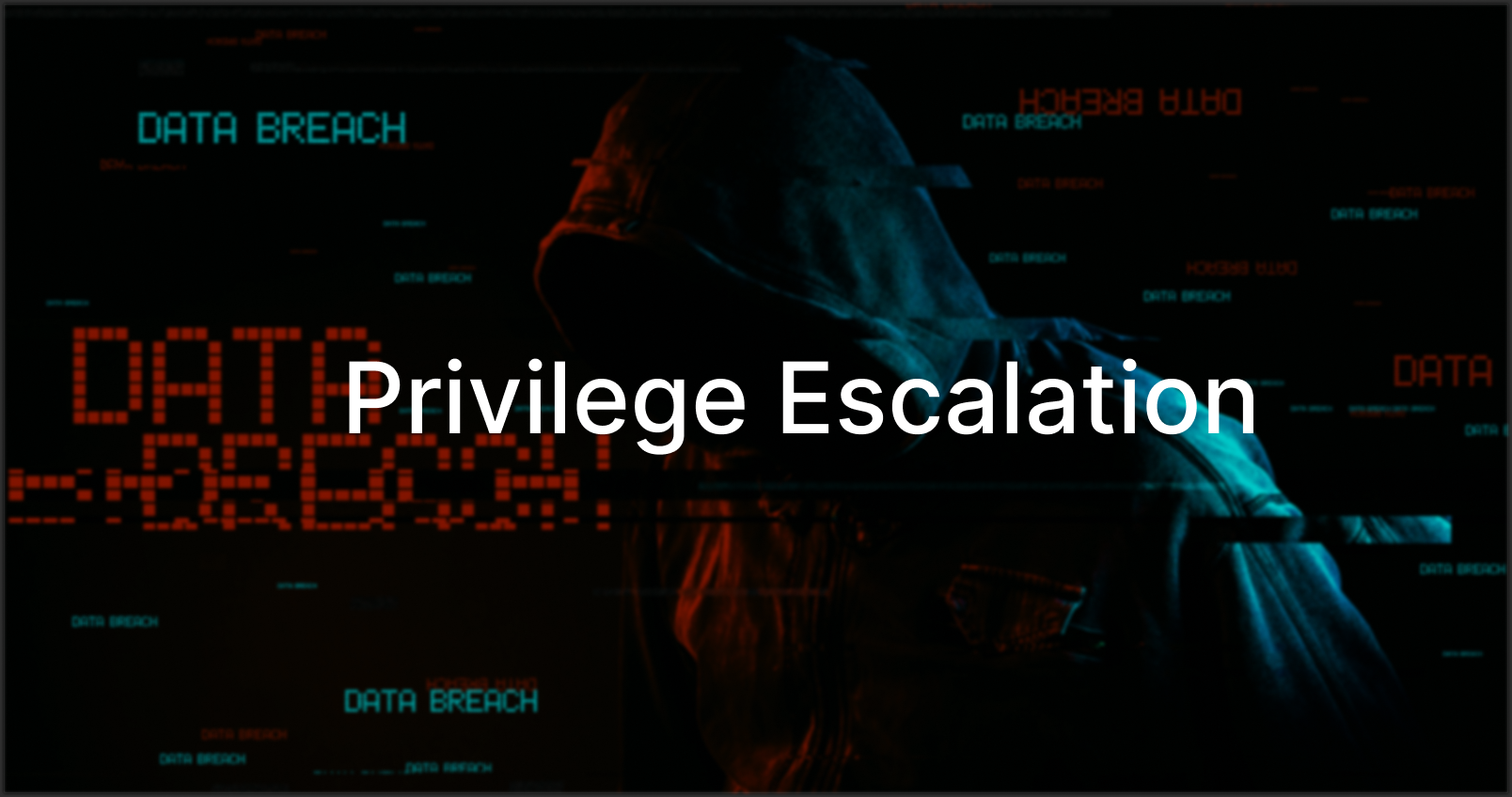Privilege Escalation
 Shubhankar Gupta
Shubhankar Gupta
What Is Privilege Escalation?
Privilege escalation is a process where an attacker gains elevated access to resources that are normally protected from an application or user. The result is that the attacker obtains privileges that they are not supposed to have, potentially compromising the security of the system. This is closely associated with lateral movement strategies, which are used by attackers to penetrate further into a network in pursuit of valuable assets.
An external or internal user with unauthorized system privileges is the end outcome. Malicious actors may cause slight or significant harm, depending on the scope of the breach. This might be as easy as an unsanctioned email or as complex as a ransomware attack on massive volumes of data. Attacks have the potential to create advanced persistent threats (APTs) to operating systems if they go unnoticed.
How Privilege Escalation Works
Initial Access: Attackers often start by using social engineering techniques, such as phishing, to compromise an individual’s account. Alternatively, they may exploit vulnerabilities in an organization’s cybersecurity framework to gain initial access.
Exploiting Weaknesses: Once inside the system, attackers look for weaknesses to escalate their privileges. These weaknesses could be due to misconfigurations, design flaws in operating systems or web applications, or inadequate access controls.
Privilege Escalation Techniques
A privilege escalation technique can be executed locally or remotely. Local privilege escalation begins onsite, often by someone inside the organization. Remote escalation can begin from almost anywhere.
Both Windows servers and Linux operating systems are vulnerable to attacks. Windows privilege escalation often employs token manipulation, user account control bypass or DLL (dynamic link library) hijacking. Common Linux system privilege escalation attacks include enumeration, kernel exploit and using Sudo access to gain root privileges. The access provided by stolen credentials is so powerful, attackers are highly motivated to find new ways to escalate Linux privileges.
Windows Server Vulnerabilities and Attacks
Windows servers are particularly susceptible to privilege escalation attacks due to their complex permission structures and the extensive use of administrative privileges for management tasks. Common techniques used in Windows privilege escalation include:
Token Manipulation: Tokens represent the security context of a user or process. Attackers can manipulate tokens to elevate their privileges. For example, an attacker might inject a token into a process that has higher privileges than the attacker’s current token.
User Account Control (UAC) Bypass: UAC is a security feature in Windows that helps prevent unauthorized changes to the operating system. However, attackers can bypass UAC through various methods, such as exploiting vulnerabilities in the Windows shell or using tools designed to disable UAC.
DLL Hijacking: Dynamic Link Libraries (DLLs) contain code and data that can be used by multiple programs at runtime. An attacker can replace a legitimate DLL with a malicious one, causing the program to execute the attacker’s code with the same privileges as the original program.
Linux Operating System Vulnerabilities and Attacks
Linux systems also face significant risks from privilege escalation attacks, primarily due to their powerful command-line interfaces and the wide range of administrative tasks that can be performed. Common Linux privilege escalation techniques include:
Enumeration: Attackers enumerate system users and groups to identify potential targets for privilege escalation. Tools like
ls,cat /etc/passwd, andgetent groupcan reveal valuable information about the system's configuration.Kernel Exploit: The Linux kernel is a prime target for exploitation because it has broad access to the system. Kernel vulnerabilities can allow an attacker to elevate privileges or gain root access.
Sudo Access Abuse: The
sudocommand allows users to run commands with the security privileges of another user, typically the superuser. Attackers can abuse this functionality by exploiting misconfigurations or vulnerabilities in the sudo setup to gain root privileges.
Types of Privilege Escalation
Privilege escalation technique can be broadly categorized into vertical and horizontal privilege escalation. Each category employs different strategies and attack vectors to achieve the goal of elevating access rights.
1. Vertical Privilege Escalation:
Vertical privilege escalation involves an attacker gaining access to an account with higher privileges than their current level. This could mean escalating from a standard user account to an administrator account. Techniques used in vertical privilege escalation include:
Exploiting Software Bugs: Attackers may find vulnerabilities in software applications that allow them to escalate their privileges. This could involve exploiting a bug that grants elevated permissions when certain conditions are met.
Misconfigurations: System administrators sometimes misconfigure security settings, leaving doors open for attackers to exploit. For instance, improperly configured permissions or overly permissive access controls can facilitate privilege escalation.
Social Engineering: Attackers may use deceptive tactics, such as phishing emails, to trick users into providing their credentials or performing actions that result in privilege elevation.
2. Horizontal Privilege Escalation:
Horizontal privilege escalation occurs when an attacker moves laterally across the system, accessing other accounts with similar privilege levels. This does not necessarily involve gaining higher privileges but rather leveraging existing access to reach other parts of the system. Techniques for horizontal privilege escalation include:
Credential Theft: Attackers steal credentials from users with similar access levels, allowing them to impersonate these users and access restricted resources.
Session Hijacking: By intercepting or hijacking sessions between legitimate users and the system, attackers can assume the identity of these users temporarily.
Leveraging Shared Resources: Attackers may exploit shared resources or services accessible by multiple users with similar privileges. For example, injecting malicious code into a shared application that users frequently run.
Common Attack Vectors
Regardless of whether the attack is vertical or horizontal, privilege escalation often exploits common vulnerabilities and misconfigurations. Some of the most prevalent attack vectors include:
Stolen Credentials: Compromised login details provide direct access to a user account, which can then be escalated to higher privileges.
Misconfigured Authentication: Failure to secure authentication mechanisms, such as weak passwords or improperly configured multi-factor authentication (MFA), can be exploited.
Malware: Malicious software installed on a system can manipulate permissions or exploit vulnerabilities to elevate privileges.
Social Engineering: Deceptive tactics, such as phishing, can trick users into divulging sensitive information or performing actions that aid in privilege escalation.
Mitigation Strategies
To protect against privilege escalation attacks, organizations should implement several defensive measures:
Least Privilege Principle: Grant users the minimum level of access necessary for their job functions.
Regular Patching and Updates: Keep systems and software up-to-date to address known vulnerabilities.
Multi-Factor Authentication (MFA): Implement MFA to add an extra layer of security to user authentication processes.
Privileged Access Management (PAM): Manage and monitor access to privileged accounts to ensure only authorized users have access.
Monitoring and Logging: Implement robust monitoring and logging to detect unusual activities that could indicate privilege escalation attempts.
Subscribe to my newsletter
Read articles from Shubhankar Gupta directly inside your inbox. Subscribe to the newsletter, and don't miss out.
Written by
